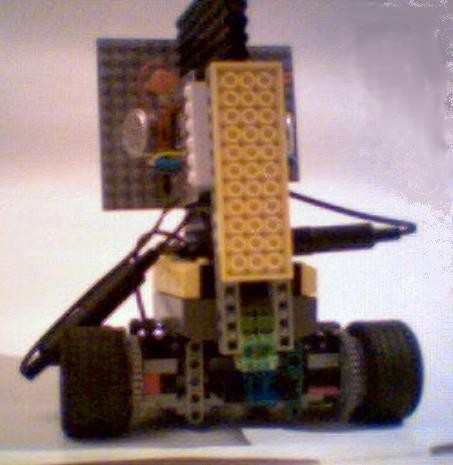
Electronical Cricket
|
|
We are on stage again with something new!
The challenge:
Is it possible with a minimum of electronics to produce a robot able to find a pulsing sound-source?
The answer:
These will be two identical sound-level sensors.
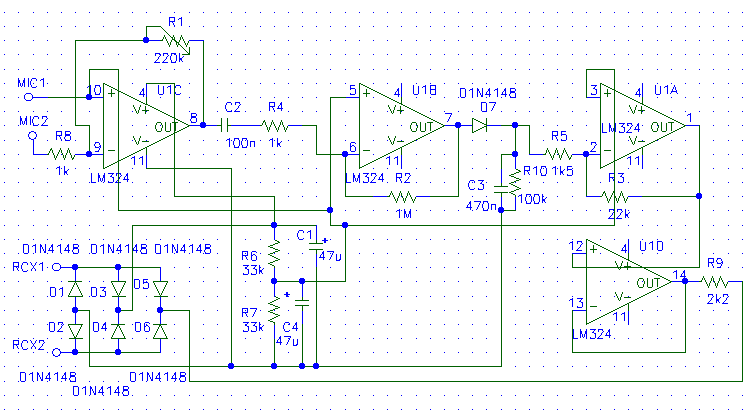
The sensor is derivated from Mike Gasperi's Almost Ultrasonic Motion Sensor . We added a forth amplifier-stage. The sensor is equipped with the cheapest crystal microphone. For each ear there are two audio-amplifier stages. The signal passes the diode D7. The positive peak charges C3 which is then discharged through R10 (the time constant T=RC=0,470E-6*1E5=0,047 sec). The peak-level is amplified and passed to the RCX through the 4th op-amp. The sensor has to be calibrated at R1. The RCX raw-values: +/-10-90.
Put attention that for the three first stages the + inputs are connected to the common ground, which is given through R6 and R7. One pin of the microphone is also connected to this ground.
Here the PC board:
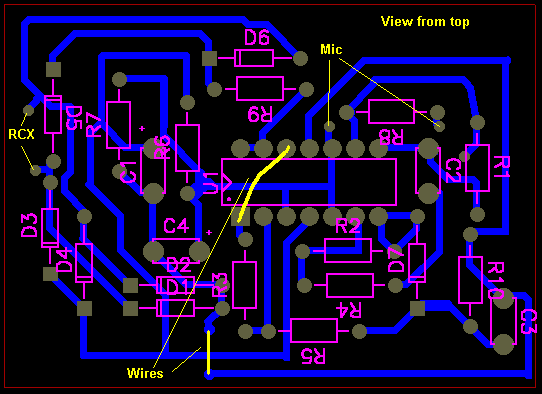
a detail view of the finished ear:

With a pulsing sweep_fast_sound from a second RCX, Robolab-tests give us the following result:
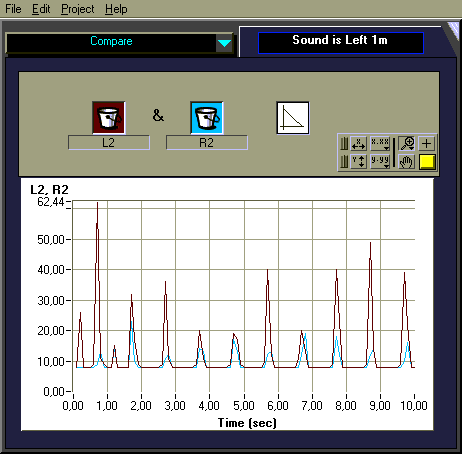
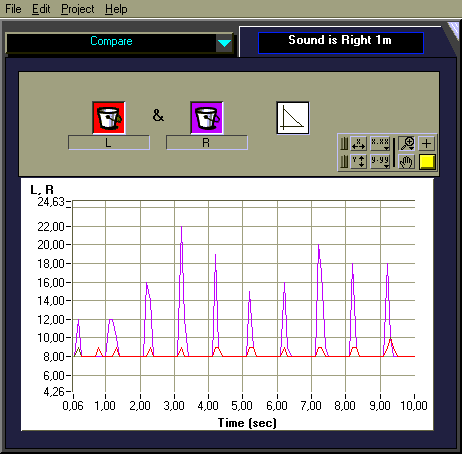
The comfortable difference of the peak-values makes possible a clear right-left decision.
{Roverbot equipped with dual-sound
sensor. Do not forget that the program
should start during silence. Then using
a second RCX run there the beeper-program}
{...variables...}
#define
(Threshold_L,0)#define(Max_L,1)
#define(Value_L,2)
#define(Actual_L,3)
#define(Threshold_R,4)
#define(Max_R,5)
#define(Value_R,6)
#define(Actual_R,7)
#define(diff,8)
#define(average,9)
#define(direction,10)
#define(abs_average,11)
#define(Motor_command,12)
#define(Motor_flag,13)
{....sensors...}
#define
(Left_EAR,0)#define(Right_EAR,2)
{....sensortype....}
#define
(Sound_type,3){...tasks...}
#define
(Ear_L,1)#define(Ear_R,2)
#define(Compare,3)
#define(motor_control,4)
{...constants...}
#define
(comm_forward,1)#define(comm_left,2)
#define(comm_right,3)
#define(Threshold,15)
#define(off,0)
#define(on,1)
{....motors...}
#define
(drive_motors,4)#define(left_motor,0)
#define(right_motor,2)
{-------------------------------------------------}
BeginOfTask(Main)
setvar(motor_flag,con,off)
{this flag shows the sound-tasksnot to check sound during driving
to avoid motor-noise}
Wait
(con,100) {to avoid beep_influence from run}
Starttask
(Ear_L)Starttask(Ear_R)
Starttask(Compare)
Starttask(Motor_control)
EndOfTask()
{-----------------------------------------------}
beginoftask(compare)
setvar(average,con,0)
{clear average difference of Left-Right-peak}loop
(con,forever)if(var,motor_flag,eq,con,off)
{do this only if not driving}setvar
(diff,var,Value_L)subvar(diff,var,Value_R)
mulvar(average,con,2)
{weighted average}sumvar
(average,var,diff)divvar(average,con,3)
setvar(direction,var,average)
absvar(abs_average,var,average)
if(var,abs_average,LT,con,Threshold)
{sound is straight forward}setvar
(motor_command,con,comm_forward)else()
if(var,direction,GT,con,0)
{sound is left}setvar
(motor_command,con,comm_left)else()
{sound is right}setvar
(motor_command,con,comm_right)endif()
endif()
endif()
endloop()
endoftask()
{-------------------------------------------------------------}
BeginOfTask(Ear_L)
SetSensorType(Left_EAR,Sound_type)
SetSensorMode(Left_EAR,percent_mode,0)
Setvar(Threshold_L,senval,Left_EAR)
SetVar(Max_L,var,0)
{fix threshold}SetVar
(Value_L,var,Threshold_L) {initial value}Sumvar(Threshold_L,con,1)
loop(con,forever)
if(var,motor_flag,eq,con,off)
{check oly if no motor-noise}Setvar(actual_L,senval,Left_EAR)
{get the sensor-value}If(var,actual_L,LT,var,Max_L)
if(var,actual_L,LT,var,Threshold_L)
{find peak}setvar
(value_L,var,Max_L) {value_L is the real peak}setvar(Max_L,con,0)
{clear max_L}endif()
else()
Setvar(Max_L,var,actual_L)
{max_L is actual peak}Endif()
endif()
endloop()
EndOfTask()
{---------------------------------------------------}
BeginOfTask(Ear_R)
SetSensorType(Right_EAR,Sound_type)
SetSensorMode(Right_EAR,percent_mode,0)
Setvar(Threshold_R,senval,Right_EAR)
SetVar(Max_R,var,0)
SetVar(Value_R,var,Threshold_R)
Sumvar(Threshold_R,con,1)
loop(con,forever)
if(var,motor_flag,eq,con,off)
Setvar(actual_R,senval,Right_EAR)
If(var,actual_R,LT,var,Max_R)
if(var,actual_R,LT,var,Threshold_R)
setvar(value_R,var,Max_R)
setvar(Max_R,con,0)
endif()
else()
Setvar(Max_R,var,actual_R)
Endif()
endif()
endloop()
EndOfTask()
{-----------------------------------------------------}
beginoftask(motor_control)
setpower(drive_motors,con,3)
loop(con,forever)
off(drive_motors)
wait(con,50)
{wait a bit}setvar
(motor_flag,con,off)wait(con,200)
{wait one second and check sound}setvar
(motor_flag,con,on)wait(con,20)
{wait tasks to finish}if
(var,motor_command,eq,con,comm_forward)setfwd(drive_motors)
on(drive_motors)
wait(con,100)
{wait 5 seconds}endif
()if(var,motor_command,eq,con,comm_left)
setfwd(right_motor)
setrwd(left_motor)
on(drive_motors)
wait(con,30)
{wait 3 seconds}endif
()if(var,motor_command,eq,con,comm_right)
setfwd(left_motor)
setrwd(right_motor)
on(drive_motors)
wait(con,30)
{wait 3 seconds}endif
()endloop()
endoftask()

These are typical ways the cricket took in a room 4m x 4m. For these experiments we used a piezo-siren from CONRAD electronics (Part. No. 115983-88) which we placed in a package made of LEGO-bricks. Then we powered it with power-level 1 ! Amazing ! You think you'll listen to a real cricket. Due to the extrem loudness (at 9V 110dB), we added a sound absorber, e.a. a LEGO half-spherical window from a space or underwater-set.
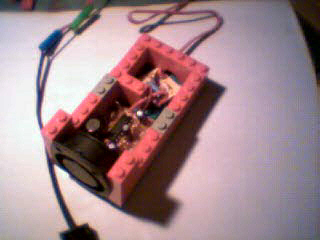
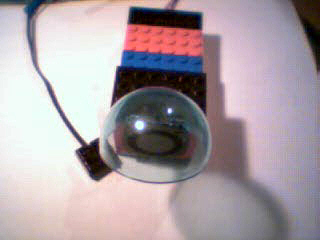
Cricket 1 and 3 found the path. Cricket 2 hit the wall because of strong echo. So we think that the next tests will be outside! We wait for better weather.
Perhaps a next cricket will not only make the difference of signal-strength but will also consider the phase-difference.
'Using Robots to Model Animals: A Cricket Test', Barbara WEBB in: Robotics and Autonomous Systems, bd 16, 2-4, p. 117ff. 1995
'Eine elektromechanische Grille', Barbara WEBB in: Spektrum der Wissenschaft, Mai 1997, S.78ff (this is the German edition of the Scientific American)
'Adaptive LEGO robots', Henrik Hautop LUND et al, LEGO Lab, University of Aarhus, Aabogade 34, 8200 Aarhus N., Denmark, http://legolab.daimi.au.dk